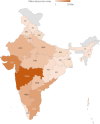Mucormycosis: A Rare disease to Notifiable Disease
- PMID: 38561499
- PMCID: PMC11153412
- DOI: 10.1007/s42770-024-01315-z
Mucormycosis: A Rare disease to Notifiable Disease
Abstract
Mucormycosis is the third most frequent invasive mycosis, following candidiasis and aspergillosis. It is frequently neglected due to its rare occurrence; but recently attend the status of notifiable disease due to its higher incidence in both developed and developing nations. India has received global notice since its estimated instances were greater than the global estimated figures. Mucormycosis has several clinical manifestations, including rhino-orbital-cerebral (ROCM), pulmonary, gastrointestinal, cutaneous, renal, and diffuse Mucormycosis. ROCM is the most frequent clinical manifestation in India, although pulmonary mucormycosis is prevalent worldwide. This review also discusses host defenses, pre disposing risk factors and fungal virulence factors that impair host's ability to prevent fungus invasion and disease establishment. The diagnosis of the disease depends on clinical interventions, histological or microbiological procedures along with molecular methods to obtain timely results. But there are still unmet challenges for rapid diagnosis of the disease. Treatment of the disease is achieved by multimodal approaches such as reversal of underlying predisposing factors, rapid administration of antifungals in optimal doses and surgical procedures to remove infected tissues. Liposomal Amphotericin B, Posaconazole and Isavuconazoles are preferred as the first line of treatment procedures. clinical trials. Different studies have improved the existing drug and under clinical trials while several studies predicted the new potential targets as CotH and Ftr1 as shown in infection and in vitro models. Therefore, current scenario demands a multidisciplinary approach is needed to investigate the prevalence, pathogenesis which is highly important for the advancement of rapid diagnosis and effective treatment.
Keywords: India; Mucorales; Mucormycosis; Notifiable disease.
© 2024. The Author(s) under exclusive licence to Sociedade Brasileira de Microbiologia.
Conflict of interest statement
The authors have no relevant financial or non-financial interest to disclose.
Figures



Similar articles
-
Breaking the Mold: A Review of Mucormycosis and Current Pharmacological Treatment Options.Ann Pharmacother. 2016 Sep;50(9):747-57. doi: 10.1177/1060028016655425. Epub 2016 Jun 15. Ann Pharmacother. 2016. PMID: 27307416 Review.
-
Epidemiology, clinical profile, management, and outcome of COVID-19-associated rhino-orbital-cerebral mucormycosis in 2826 patients in India - Collaborative OPAI-IJO Study on Mucormycosis in COVID-19 (COSMIC), Report 1.Indian J Ophthalmol. 2021 Jul;69(7):1670-1692. doi: 10.4103/ijo.IJO_1565_21. Indian J Ophthalmol. 2021. PMID: 34156034 Free PMC article.
-
Post-COVID-19 rhino-orbito-cerebral mucormycosis-A clinico-mycological study from North India.Med Mycol. 2023 Jul 6;61(7):myad067. doi: 10.1093/mmy/myad067. Med Mycol. 2023. PMID: 37442616
-
Challenges in the diagnosis and treatment of mucormycosis.Med Mycol. 2018 Apr 1;56(suppl_1):93-101. doi: 10.1093/mmy/myx101. Med Mycol. 2018. PMID: 29538730 Free PMC article. Review.
-
A prospective study of mucormycosis in north India: experience from a tertiary care hospital.Med Mycol. 2015 Apr;53(3):248-57. doi: 10.1093/mmy/myu086. Epub 2015 Jan 13. Med Mycol. 2015. PMID: 25587084
Cited by
-
Invasive Mucormycosis in a Chronic Lymphocytic Leukemia Patient on Zanubrutinib: A Case Report.Infect Drug Resist. 2025 Jul 4;18:3281-3287. doi: 10.2147/IDR.S526660. eCollection 2025. Infect Drug Resist. 2025. PMID: 40630748 Free PMC article.
-
Rhino-orbito-cerebral mucormycosis after allogeneic hematopoietic stem cell transplantation for very severe aplastic anemia in a child: a case report.Front Pediatr. 2025 Apr 14;13:1529656. doi: 10.3389/fped.2025.1529656. eCollection 2025. Front Pediatr. 2025. PMID: 40297559 Free PMC article.
-
In vitro antifungal activity of MMV Pathogen Box® compounds alone or in combination with antifungal drugs against mucormycosis agents.Curr Res Microb Sci. 2024 May 15;6:100242. doi: 10.1016/j.crmicr.2024.100242. eCollection 2024. Curr Res Microb Sci. 2024. PMID: 38799088 Free PMC article.
References
-
- World Health Organization. COVID-19 Weekly Epidemiological Update. World Heal Organ. 2022;(August):1–33. https://www.who.int/publications/m/item/covid-19-weekly-epidemiological-...
Publication types
MeSH terms
Substances
LinkOut - more resources
Full Text Sources
Medical

